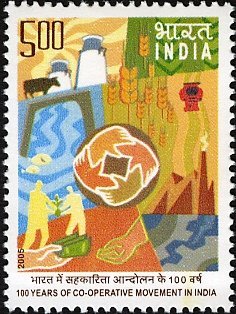Centenary of Cooperative Movement in India

Technical Data
| Stamp Set | Centenary Series |
|---|---|
| Date of Issue | May 8, 2005 |
| Denomination | Rs. 5 |
| Quantity | 400,000 |
| Perforation | comb 13¼ |
| Printer | Security Printing Press, Nashik |
| Watermark | No Watermark |
| Colors | Multicolor |
| Catalog Codes |
Michel IN 2090 Stamp Number IN 2107 Yvert et Tellier IN 1855 Stanley Gibbons IN 2274 WADP Numbering System - WNS IN021.05 |
| Themes | Agriculture | Anniversaries and Jubilees | Industry | Stylized Figures / Persons | Stylized Objects | Symbols |
Table of Contents
Commemorative Stamp Set: “Centenary of Cooperative Movement in India”
Design Elements
Visuals:
- Stamp 1: A depiction of a traditional rural marketplace, showcasing farmers and artisans exchanging goods, highlighting the roots of cooperative principles in rural India.
- Stamp 2: An image of a cooperative society office, symbolizing the organized structure that emerged in the early 20th century, with people engaging in discussions and transactions.
- Stamp 3: Visuals of a dairy cooperative, with farmers delivering milk cans and a cooperative milk van, representing the success of the cooperative movement in the dairy sector (e.g., Amul).
- Stamp 4: A collage featuring agricultural cooperatives, banking societies, and women engaged in self-help group activities, depicting the diverse aspects of the cooperative sector in India.
- Miniature Sheet: A comprehensive visual timeline starting from the inception of the cooperative movement in 1904 to its evolution and current achievements, including images of key figures and milestone moments.
Color Palette:
- Earthy tones like greens and browns to symbolize agriculture and rural prosperity.
- Bright colors like blue and yellow to represent unity, progress, and the diverse sectors of cooperatives.
Text Elements:
- Each stamp to include: “Centenary of Cooperative Movement in India,” along with key words like “Agriculture,” “Banking,” “Unity,” and “Empowerment.”
Cultural and Historical Significance
The cooperative movement in India began in 1904 with the enactment of the Cooperative Credit Societies Act, aimed at alleviating the financial struggles of farmers by providing them access to credit. Since then, it has grown to encompass various sectors, including agriculture, dairy, banking, handicrafts, housing, and more. Cooperatives played a crucial role in the Green Revolution, boosting agricultural productivity, and initiatives like the White Revolution, which transformed India into the world’s largest producer of milk. The cooperative model has empowered rural communities, facilitated financial inclusion, and enabled self-sufficiency across the country.
Usage
These stamps can be used for:
- Postage: Recognizing and celebrating the achievements of the cooperative sector through regular mailing services.
- Educational and Awareness Campaigns: Informing the public about the benefits of cooperative societies, particularly in rural areas, and encouraging the formation of new cooperatives.
- Commemorative Collectibles: Popular among philatelists and those interested in the history of social and economic development in India.
Importance of the Commemorative Stamp Set
This stamp set marks 100 years of the cooperative movement, highlighting its importance in India’s economic and social fabric. The cooperative model has been instrumental in empowering farmers, artisans, and small business owners by fostering a spirit of collaboration, mutual support, and shared prosperity. Recognizing this centenary through a commemorative set reinforces the significance of community-driven economic development and the role of cooperatives in building a self-reliant and inclusive economy.
Example of the Stamp Design
- A stamp featuring an image of a rural cooperative society office with farmers and villagers, capturing the essence of community cooperation.
- Another stamp showcasing a dairy cooperative setup, with farmers delivering milk and processing units, symbolizing the success of cooperatives in the dairy sector.
Significance
The commemorative stamp set underscores the centenary of the cooperative movement in India, celebrating its achievements and its ongoing contribution to economic growth, rural development, and financial inclusion. It serves as a tribute to the spirit of self-reliance and unity that defines the cooperative model, reflecting its role in empowering communities across the nation.
